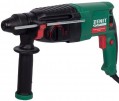Power consumption
Rated power consumed by the rotary hammer during operation. Usually, the maximum power consumption in normal operation is taken as the nominal power.
In general, the higher this indicator, the heavier and more performant the rotary hammer is, the more advanced its performance usually turns out to be. On the other hand, the electricity consumption of such tools is high. In addition, note that with the same power consumption, the actual set of individual characteristics for different tools may be different. For example, frequency and impact energy are inversely related, and for the same power input, higher frequency usually means less individual impact energy. So, according to this parameter, it is worth evaluating only the overall level of the instrument; for accurate selection for specific tasks, you need to pay attention to more specific characteristics.
Also note that power consumption data can be useful for some tasks related to catering — for example, if a construction site is powered by an autonomous generator and you need to estimate the load on this energy source.
In box
—
Additional handle. The presence of an additional front handle on the hammer drill, usually located at the base of the chuck. This handle can be non-removable or removable, rigidly fixed or movable. Holding two handles with two hands is much more convenient than holding one and the body, as it allows for optimal distribution of the load on the hands; this is especially important during long-term work and processing of “heavy” materials.
—
Depth gauge. A device that allows you to make holes of a strictly defined depth in one go, without constant measurements and without the risk of drilling deeper than necessary. Usually looks like a rod fixed to the body of the hammer drill parallel to the working tool. When used, this rod extends to such a length that when the desired depth is reached, it rests against the surface of the material being processed, preventing the drill from moving further.
—
Chisel. Complete attachment for impact work with a hammer drill in the manner of chasing, leveling hard surfaces, chipping tiles, bricks, concrete, etc. Different types of chisels are produced for different tasks — flat, blade, groove, crushing peaks with a sharp tip.
—
Boring bit. The presence of Boring bit in the delivery set of tool designed for processing various hard materials by drilling with impact. Buying such a s
...et eliminates the need to look for a drill separately, but the characteristics of the complete attachment must be clarified before purchasing, since they may not meet the buyer's requirements.
— Charger. The presence of a charging unit in the kit allows you to charge batteries. Accordingly, for models with batteries, this accessory is necessary to power the battery. However, there are models without a charger. And hammer drills with it can differ in the model of the charger, the name of which will allow you to learn more about its characteristics and, if necessary or as needed (breakdown), buy a similar one.
— Case included. The delivery set includes a special case that facilitates storage and transportation: it provides protection from impacts and adverse conditions (moisture, frost), is equipped with a special handle for carrying, in addition, in the case, along with the hammer drill itself, a set of working tools, replacement cartridges, etc. can be placed.
— Dust collector. The hammer drill comes with a special dust collector. As the name suggests, it is designed to collect dust generated during operation, which could otherwise cause significant inconvenience. It usually looks like a bag or container attached to the body; it can be either replaceable (thrown away with the collected garbage) or permanent. The dust collector slightly increases the weight and dimensions of the hammer drill, but it can be removed if necessary.
